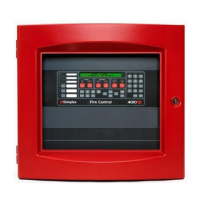1-3
Basic System Description, Continued
Overview
Note: The degree to which you are allowed to control the system depends on the passcode
assigned to you. See “Logging in and Out of the System” for details on this.
Table 1-1. Components of the Operator Interface (continued)
LED/Key Description Refer To
WARNING LED Keys
and LEDs
The WARNINGS LEDs –
SUPERVISORY and TROUBLE –
indicate when abnormal, non-fire
conditions occur to the fire alarm’s
wiring or devices. The Warning keys
– SUPV ACK and TROUBLE ACK –
allow an operator to acknowledge the
presence of the abnormal condition.
Chapter 3 for
Troubles.
Chapter 4 for
Supervisory
Conditions
SYSTEM RESET Key
Pressing this key directs the panel to
reset all attached devices and clear
all acknowledged alarms, troubles,
and supervisory conditions.
Chapter 2
AC POWER LED
Indicates the presence of AC power
at the panel.
N/A
Event Time Key
Used to display the time at which an
acknowledged alarm, trouble, or
supervisory condition occurred.
Chapter 6
Entry Keypad
Used to call up points for monitoring
and control.
Chapter 5
Facility-Specific Control
Keys
These are programmable keys.
Typical functions include manual
evacuation, ground fault monitor, etc.
N/A
Enable/Disable Keys
Pressing these keys allows you to
enable or disable devices attached to
the panel.
Chapter 6
On/Off/Auto Keys
Pressing these keys allows you to
force a device (such as a relay) ON or
OFF. The Auto key returns control of
the device to the panel.
Chapter 6
Arm/Disarm Keys
Used with security points. These
keys allow you to turn security
devices on (arm) or off (disarm).
Chapter 6
Alphanumeric Display
Displays text describing abnormal
conditions for devices attached to the
panel (i.e., smoke detector in main
lobby is in alarm). Also displays
system prompts and messages.

